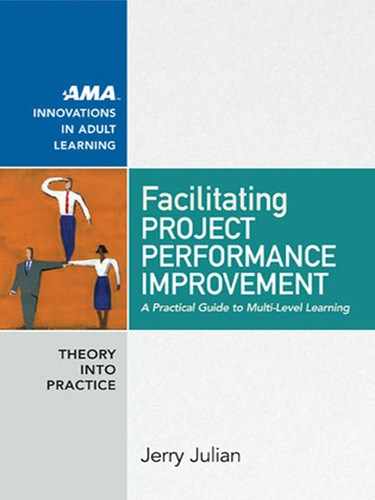American Management Association
www.amanet.org
Foreword xiii
Introduction 1
Multi- Level Learning: An Approach to Improving Project
and Program Performance 4
How This Approach Di ers from Conventional Approaches 7
Project and Program Management O ces 8
How This Book Can Help You and Your Organization 9
Who Should Read This Book 9
How This Book Is Organized 10
PART 1: FOUNDATIONS 13
CHAPTER 1: The Need for Multi- Level Learning 15
Red- Light Learning 17
Defensive Routines 19
Problems with Traditional Approaches to Learning from
Project Experience 21
From Red- Light Learning to Continuous Systems- Level Learning 24
Conclusion 25
C
HAPTER 2: Foundations and Principles of Multi- Level Learning 27
Re ection on Action 27
The U.S. Army’s After- Action Review Process 30
The Emergence of Agile Software Development Practices 31
Action- Re ection Cycles: The Foundation for Multi- Level Learning 34
Principles of Multi- Level Learning 35
CONTENTS
American Management Association
www.amanet.org
Contents ix
Satisfy the Customer 35
Eliminate Waste 36
Welcome New Insights 36
Deliver as Fast as Possible 37
Empower Team Learning 37
See the Whole 38
Use a Third- Party Coach 39
Re ect at Multiple Levels 39
Conclusion 40
PART 2: ROLES 43
CHAPTER 3: The Multi- Level Learning Coach 45
Overview of the Multi- Level Learning Coach Role 45
The Importance of Neutrality and Objectivity 47
Skills Required of the Multi- Level Learning Coach 48
Three Core Values for E ective Facilitation 51
Models for E ective Group Process 53
Goals, Roles, and Procedures 54
Communication 56
Problem Solving 60
Decision Making 61
Con ict Resolution 62
Boundary Management 66
Diagnosing and Intervening 68
Ground Rules for Groups 69
Conclusion 72
C
HAPTER 4: The Project and Program Management Function (PMO) 74
The PMO 76
Brokering and Communities of Practice 77
Research Methodology 78
How PMO Leaders Facilitate Cross- Project Learning and
Continuous Improvement 79
Brokering 80
Boundary Practices 84
Boundary Objects 88
Boundary Encounters 90
American Management Association
www.amanet.org
x Contents
Re ective Practices 93
Formal Training 94
Personal Experience as Project Manager 95
Personnel Selection 96
Enablers and Barriers That PMO Leaders Face in Facilitating
Cross- Project Learning and Continuous Improvement 96
Enablers of Cross- Project Learning and Improvement 97
Barriers to Cross- Project Learning 103
The Challenges of Brokering 109
Conceptual Framework for the PMO Leader Role 113
The PMO and Multi- Level Learning 117
The PMO Leader as Knowledge Broker 117
Transferring Improved Practices via Organizational Routines 117
Legitimacy and the Need for Social Capital 118
Defensive Routines Undermine Improvement 118
Lack of Awareness of the Importance of Productive Re ection 119
Recommendations for PMO Leaders 119
Conclusion 122
PART 3: IMPLEMENTING MULTI- LEVEL LEARNING 123
CHAPTER 5: Facilitating Level 1: Continuous Project Improvement 125
Overview of Level 1: Continuous Project Improvement 125
Step 1: Plan and Conduct the Prospective 127
Step 1a: Determine the Goals, Roles, and Deliverables 127
Step 1b: Identify the Participants 128
Step 1c: Establish the Agenda, Date, and Time for the Prospective 128
Step 1d: Conduct the Prospective 129
Step 2: Execute the Plan 129
Step 3: Plan and Conduct the Retrospective 129
Step 3a: Collect Performance Feedback 130
Step 3b: Assess Team Members’ Perceptions 131
Step 3c: Establish the Agenda, Date, and Time 132
Step 3d: Conduct the Retrospective 135
Step 4: Update Project Plans, Issues, Risks, and Lessons Learned 136
Conclusion 137
American Management Association
www.amanet.org
Contents xi
American Management Association
www.amanet.org
CHAPTER 6: Facilitating Level 2: Cross- Project Improvement 138
Overview of Level 2: Cross- Project Improvement 139
Step 1: Plan and Conduct the Prospective 140
Step 1a: Identify Cross- Project Improvement Opportunities 140
Step 1b: Recruit Participants 141
Step 1c: Draft an Improvement Charter 142
Step 1d: Establish an Agenda, Date, and Time 142
Step 1e: Conduct the Prospective 143
Step 2: Pilot Improvements 144
Step 3: Plan and Conduct the Retrospective 145
Step 3a: Meet with Participants Individually 145
Step 3b: Gather Data 145
Step 3c: Establish the Agenda, Date, and Time for the Retrospective 146
Step 3d: Conduct the Process Retrospective 147
Step 4: Transfer Improvements to New and Existing Projects 148
Conclusion 148
C
HAPTER 7: Facilitating Level 3: Strategic Portfolio Alignment 150
Overview of Level 3: Strategic Portfolio Alignment 151
Step 1: Plan and Conduct the Prospective 153
Step 1a: Identify and Clarify Strategic Objectives 154
Step 1b: Develop a List of Investment Priorities 154
Step 1c: Identify the Participants 156
Step 1d: Assess Team Members’ Readiness 156
Step 1e: Clarify Decision- Making Roles and Responsibilities 157
Step 1f: Obtain the Project Dashboard 157
Step 1g: Establish the Agenda, Date, and Time for the
Strategy Prospective 157
Step 1h: Conduct the Prospective 160
Step 2: Execute the Strategy 161
Step 3: Plan and Conduct the Portfolio Retrospective 161
Step 3a: Collect Project and Program Performance Data 162
Step 3b: Meet with Team Members Individually 163
Step 3c: Establish the Agenda, Date, and Time 164
Step 3d: Conduct the Retrospective 166
Step 4: Update the Project Portfolio and Capture Action Items 167
Conclusion 167
American Management Association
www.amanet.org
xii Contents
CHAPTER 8: Conclusion 169
APPENDIX A: Problems with Traditional “Lessons-Learned”
Practices 171
The Role of Social Practices 172
Process vs. Product Knowledge 174
Project Organization and the Dilemma of Process Knowledge 175
Summary 176
A
PPENDIX B: Situated Learning and Communities of Practice 178
Situated Learning and Legitimate Peripheral Participation 178
Apprenticeship 179
Situated Learning 180
Legitimate Peripheral Participation 181
Communities of Practice 181
Practice as the Basis for the Production of Meaning 182
Practice as the Source of Community Coherence 183
Practice as a Learning Process 184
Practice as the Source of Boundaries Between Interlinked Communities 185
Project Environments and Communities of Practice 188
Limitations of Communities of Practice in Relation to
Cross- Project Learning 189
References 191
Index 197
..................Content has been hidden....................
You can't read the all page of ebook, please click here login for view all page.
